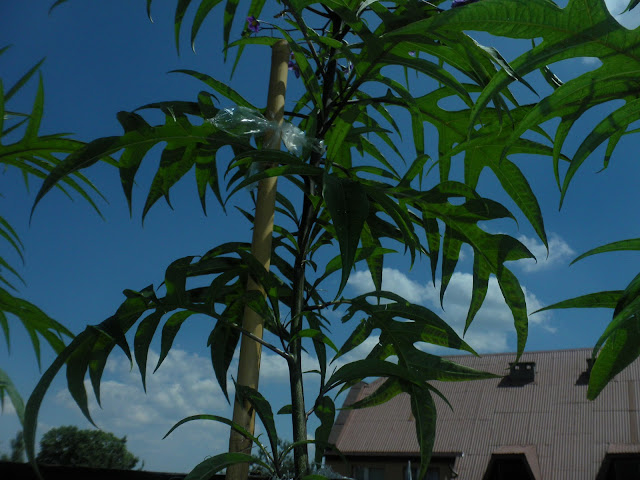Kangaroo
Apples – the 8 species of genus Solanum which
belong to section Archaesolanum grow in wild state in
Australia, New Zealand and New Guinea areas. They all are
(semi-)evergreen medium size shrubs with more or less lobed leaves
and fleshy berries which break and fall down when ripe. The fruits of
the most species are edible. Every one have other taste and color.
They have exotic aroma and are very delicious. They are also very
ornamental due to a profusion of blue flowers and colorful fruits.
Inside of fruits there are not only seeds but also stone cell
granules which have various shape and size (in the same fruit).
The flowers of three species: left - Solanum linearifolium (Mountain Kangaroo Apple), middle - S. laciniatum (Southern Kangaroo Apple) and right - S. aviculare (Rainforest Kangaroo Apple)
(more photos bellow)
Growing:
Although
they are subtropical and needs long growing period I discovered that
some species can be successful grown as annual in temperate gardens.
They only need to be sown very early inside – in January-March and
replanted to a garden after last frosts. Then the fruits are ripening
in August and September. They love much of warm and sunlight. There
is very difficult to buy viable seeds, especially rarer species. The
seeds should be sown surface. GA3 (2000ppm by 24 hours) can increase
germination rate. They germinate usually within 2-4 weeks. The plants
are suitable to growing in medium size pots.
The
names of taxons which I tried to grow are bolded and below of an each
description there are visible their images. All photos were made by
me in my garden and balcony in last a few years. I grown 5 species.
Four of them (S. laciniatum, S. aviculare, S. vescum and S.
linearifolium) can be successful grown outside in temperate areas
if sown early. The fifth species – S. symonii is more
difficult (it is later and ripens as late as in mid autumn).
Description
of species:
The best known and often cultivated there is S. laciniatum
(Large Kangaroo Apple, Southern Kangaroo Apple). It occurs in wild
state in extreme south-east Australia and Tasmania. It has
rotate-shaped blue flowers and orange fruits (delicious raw or
cooked).
Solanum laciniatum
Solanum
laciniatum is often confused with other species – S.
aviculare (Rainforest Kangaroo Apple) native to eastern
Australia. The last one differs by very small seeds, star-shaped
flowers and darker (almost red) fruits. It is one of the parents of
hybrid S. laciniatum (the natural crossing of S. aviculare
and S. vescum). Fruits of S. aviculare are edible only
in small quantity (larger amounts can be a little harmful). It is
difficult to find the seeds of true S. aviculare (often they
are falsified by S. laciniatum).
Solanum aviculare
The
mentioned above S. vescum (Gunyang, Green Kangaroo
Apple) is characterized by large (probably the largest in the
section) pale blue flowers, huge lobed leaves and yellowish-green
fruits. It is native to south-east Australia. The fruits are very
delicious and (as the only in the species which I know) something
resemble true apples in taste.
Solanum vescum
S.
linaearifolium (Mountain Kangaroo Apple) has narrower leaves
than other species. Its flowers are dark blue and fruits pale yellow
with large purple spot on the side which is in the sun. It is also
native to south-east of Australia. The fruits are delicious after
boiling. In raw state they have odd taste.
Solanum linearifolium
The comparison of fruits of Solanum linearifolium (on right) and S. laciniatum (on left)
The comparison of leaves of Solanum linearifolium (on left) and S. laciniatum (on right)
S.
symonii (Wepping Dune Tomato) occurs in south-west Australia.
It is similar to other species but fruits are small and have
purple-whitish-green color. The taste is good, exotic. As I wrote
above it grows more slowly and ripens late.
Solanum symonii
There
are 3 species more yet: S. simile (Oondoroo) native to whole
south Australia, S. capsiciforme (Native Pepper) with
green elongated fruits (resembling a hot pepper) which occurs in south-west
and middle-south Australia and S. multivenosum (unknown common
name) from New Guinea. The seeds of first two species are relatively
easy to getting but often (in my experience always) not germinate. If
you have available the fresh seeds of any of three last species
please write to me.













































Hi, not sure if you still check this blog but I am an avid collector of Solanums and I live in Western Australia. I have a few hundred Solanum simile fruits currently ripening that I would be willing to part with. I use native Solanum species as scion for South American species such as Solanum quitoense. If interested, contact me at Joel.parkes@gmail.com
ReplyDelete